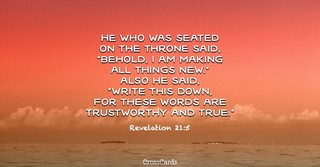- Recent Translations
- All Translations
Revelation 21:20
Share
Settings
Revelation 21:20 Meaning and Commentary
The fifth, sardonyx
Which is partly of the sardian, and partly of the onyx stone, which resembles a man's nail, from whence it has its name; it is reddish, bordering on white; it may be thought to answer to the onyx in the breastplate, on which was written the name of Joseph.
The sixth, sardius;
the same with the sardine stone, ( Revelation 4:3 ) of a blood colour, and what is commonly called a cornelian: it is found in Sardinia, from whence it has its name, and in Bohemia and Silesia, though those of Babylon are the best. This was Reuben's stone.
The seventh, chrysolite;
a stone of a dusky green colour, with a cast of yellow; by its name it should have the colour of gold. Schroder says it is found in Bohemia, and that it is the same the moderns call the topaz. Some think it answers to "tarshish" in the breastplate, rendered "beryl", on which was the name of Asher.
The eighth, beryl;
a stone of a pale green colour, thought to be the diamond of the ancients: it may answer to the "ligure" in the breastplate, which the Targum on ( Song of Solomon 5:14 ) calls "birla", and had the name of Dan on it.
The ninth, a topaz;
a stone very hard and transparent, of a beautiful yellow, or gold colour: the topaz of Ethiopia was counted the best, ( Job 28:19 ) . Some say it is so called from the island "Topazus"; on this stone Simeon's name was engraven.
The tenth, a chrysoprasus;
a stone of a green colour, inclining to that of gold, from whence it has its name; for this is the agate in the breastplate, which was Napthali's stone.
The eleventh, a jacinth;
or "hyacinth": a stone of a purple, or violet colour, from whence it has its name; though what the moderns so call is of a deep reddish yellow, pretty near a flame colour. Zabulon's stone was the diamond.
The twelfth, an amethyst;
a stone of a violet colour, bordering on purple: it has been thought a preservative from drunkenness, from whence it seems to have its name. On this stone was written the name of Gad. Agreeably to this account of John's, the Jews speak F14 of the tabernacle above being built on twelve precious stones; and sometimes they say F15, that the holy blessed God will found Jerusalem with ten kind of precious stones, and which they mention, and several of which are the same with these.
F14 Zohar in Gen. fol. 17. 2. & in Exod. fol. 65. 4.
F15 Abkath Rocel, p. 150. Vid. Zohar in Exod. fol. 96. 3.
